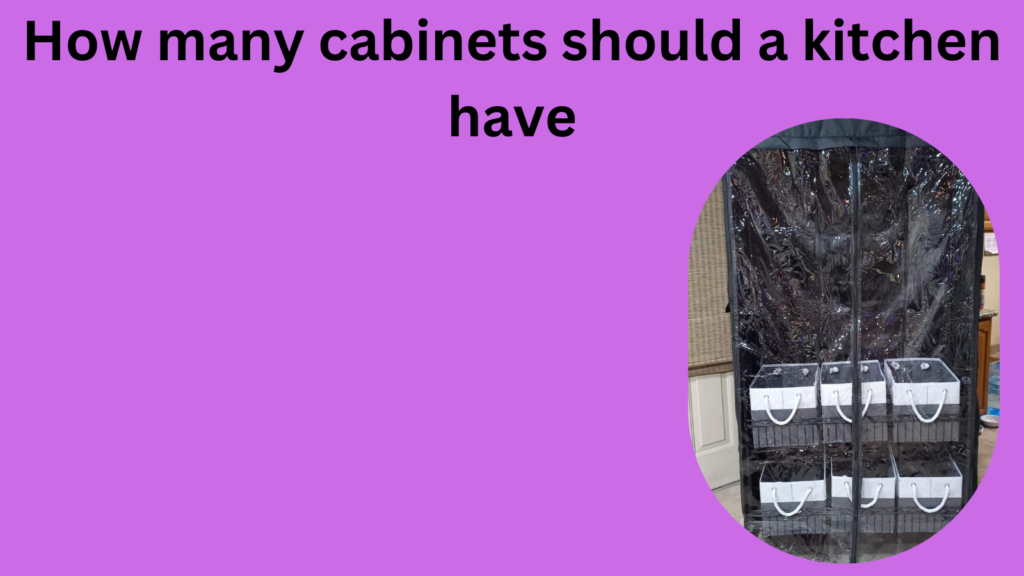Ever feel like your kitchen is always running out of space? I’ve been there—stacking pans, squeezing in spices, and still wondering, how many kitchen cabinets do I need? The answer isn’t a guess. It depends on your kitchen size, how much you cook, and how much cabinet space you need. I’ll share my kitchen remodel story, mistakes to avoid, and simple tips to help you figure it out. Let’s make your kitchen work for you!
Assessing Your Kitchen Needs
Importance of Planning
Planning your kitchen cabinets isn’t just about looks—it’s about making life easier. Without a plan, you might not have enough space or the right setup. I learned this the hard way. After my remodel, I realized I had nowhere to store my big appliances.
A common mistake is not thinking ahead. Another is picking cabinets that look nice but don’t work well. Before making changes, think about what you need to store, how often you cook, and how you use your kitchen. A little planning now saves a lot of stress later.
Factors to Consider
Kitchen Size
Your kitchen layout affects how many cabinets you need. A small kitchen needs smart storage like pull-out shelves. A big kitchen can fit more cabinets. If space is tight, focus on using every inch instead of adding more cabinets.
Number of Household Members
More people mean more storage needs. A single person may need fewer cabinets, but a family needs extra space for snacks, dishes, and cooking tools. If more than one person cooks, having storage in the right spots keeps things neat.
Cooking and Storage Needs
Think about how you cook. If you love baking, you’ll need room for bowls, trays, and mixers. If you cook quick meals, easy-access cabinets are a must. Stock up on groceries? Deep pantry cabinets help keep things in order. Your kitchen should fit your lifestyle.
Personal Experience
When I planned my kitchen, I listed everything I needed to store. Then, I measured my space and mapped it out. I even tested different setups using my old cabinets. This helped me avoid mistakes and use space wisely.
Not sure where to start? Take stock of your kitchen. What do you use daily? What do you rarely touch? This helps you decide how many cabinets you need without wasting money or space.

Calculating Cabinet Space Requirements
How Much Cabinet Space Do I Need?
Ever had a cabinet overflow when you opened it? I sure have! That’s when I realized I needed to plan better. The trick is to figure out how much space you need before buying cabinets. Let’s make it easy.
Standard Cabinet Sizes
Most kitchen cabinets follow standard sizes. Wall cabinets are usually 12 to 24 inches deep. Base cabinets are 24 inches deep and 34.5 inches tall. Pantry cabinets can be 84 to 96 inches tall. Knowing these numbers helps you plan smart.
Easy Way to Calculate Space
First, list everything you need to store—plates, pans, dry goods, and appliances. A good rule: each person needs about 12-15 cubic feet of storage.
Another tip? Divide your kitchen into zones—one for cooking, one for prep, and one for storage. Then, assign cabinets to each zone. This keeps things neat and easy to find.
What Experts Recommend
Experts say a mix of base cabinets, wall cabinets, and drawers works best. Deep drawers are great for pots and pans. Upper cabinets hold dishes. If your kitchen is small, pull-out shelves and corner cabinets help you fit in more.
My Experience
When I remodeled my kitchen, I thought I had enough cabinets. But I forgot about vertical space! Adding stackable shelves and organizers made a huge difference. Before buying more cabinets, check if you’re using what you have wisely.
Start small. Measure, test layouts, and adjust. The best kitchen isn’t about how many cabinets you have—it’s about making the space work for you.
How Many Drawers Should a Kitchen Have?
Ever struggled to find a spoon in a messy drawer? I have! My kitchen used to have just a few deep drawers, and everything got lost inside. After my remodel, I learned the right number of drawers makes life easier. But how many do you need? Let’s find out.
Types of Drawers
Not all drawers are the same. Each has a job:
- Shallow Drawers are best for utensils, measuring cups, and small tools.
- Medium Drawers – Great for plates, bowls, and food containers.
- Deep Drawers – Perfect for pots, pans, and big kitchen items.
A mix of these keeps your kitchen neat. Too many shallow ones, and big items won’t fit. Too few, and everything gets stacked.
How Many Drawers Do You Need?
Experts say most kitchens need four to six drawers. But it depends on you:
- Cook simple meals? Three or four should work.
- Love baking? Extra drawers help store mixing tools.
- Big family? More drawers keep dishes, snacks, and utensils in place.
A good setup: one deep drawer, two medium ones, and two or three shallow ones. This keeps things organized without wasting space.

What to Think About
Easy access matters. Pull-out drawers work better than deep cabinets. No more bending down to dig for a pan!
Keep things where you use them. Put everyday tools in top drawers. Store less-used items lower. If you have kids, keep their plates in a drawer they can reach.
My Kitchen Mistake
At first, I didn’t add enough drawers. I thought cabinets were enough. Bad idea! My pots stacked up, and finding lids was a daily struggle.
I fixed it by adding deep drawers under my stove for cookware. I put medium ones near the sink for plates. Everything got easier.
How Many Cabinets Should a Kitchen Have?
Ever walked into a kitchen and thought, “Wow, this feels just right!”? The number of cabinets plays a big role in that. Too few, and you’re struggling to find space. Too many, and your kitchen might feel cramped. So, how many do you really need? Let’s break it down.
Layout Considerations
Your kitchen layout decides how many cabinets fit. If you have a galley kitchen, you’ll likely have cabinets on both sides. An L-shaped kitchen offers more space, while a U-shaped kitchen provides storage all around. Open-concept kitchens may need a mix of upper and lower cabinets for balance.
Quick Tip: Use vertical space wisely. Tall cabinets work great in small kitchens, while open shelving keeps a larger kitchen airy.
Functionality and Aesthetics
Cabinets should be useful and look good. Think about what you store and how often you use it. Everyday dishes? Keep them in easy-to-reach spots. Rarely used appliances? Store them higher.
A mix of cabinets and drawers keeps things organized. Deep drawers hold pots, while cabinets work for dishes. The right combo makes cooking easier.
Fast Answer: Balance is key. Mix drawers and cabinets to match your cooking habits.
Custom vs. Ready-Made Cabinets
Should you get custom cabinets or buy ready-made ones? Custom cabinets fit your space perfectly but cost more. Ready-made ones are budget-friendly and easier to install.
Key Takeaway: If you have an unusual layout, custom is best. If you want to save money, ready-made works well.
Case Study
Sarah wanted a kitchen that felt open but had enough storage. She started with a small U-shaped layout. At first, she picked too many upper cabinets, making the space feel tight. She switched to open shelving on one side and deep drawers below. The result? A functional, airy kitchen that fit her needs perfectly.
Lesson Learned: More cabinets aren’t always better. The right setup makes all the difference.
Frequently Asked Questions
How do I maximize small kitchen spaces?
Making a small kitchen feel bigger can be tricky! But here’s a simple trick: use vertical space. Go for tall cabinets and open shelves to store things up high. You can also add pull-out shelves to reach those hard-to-get spots. Multi-purpose pieces, like a kitchen island with storage below, help too. Every little change can make a big difference!
What are the latest trends in kitchen cabinetry?
Want to update your cabinets? Right now, minimalism is in style. People love sleek, handleless cabinets or two-tone color schemes for a fresh look. Natural wood is also making a comeback, and matte finishes are popular. You can even find smart cabinets that open with a tap—so cool and convenient!
How can I budget for my kitchen remodel?
Kitchen remodeling doesn’t have to break the bank. Start by knowing what you need. Custom cabinets are more expensive, but they fit perfectly in your space. If you’re on a budget, try refacing your old cabinets for a fresh look. And remember, small things like hardware and lighting add up, so include them in your budget.
Any other storage tips?
I have a few storage tricks that might help! Try using drawer dividers—they keep everything neat and easy to find. For deep pantries, stackable bins make it easy to reach your food. Don’t forget under-cabinet lighting—it helps you see everything and adds a nice touch. Rotating shelves or pull-out cabinets in your pantry can save you from digging around for things.
Conclusion
Recap Key Points
Let’s sum it up! When deciding how many kitchen cabinets you need, think about your space, how you cook, and what you need to store. Consider the size of your kitchen, how many people live in your home, and what you use daily. Don’t forget about drawers and the right layout. Planning carefully now saves you time and money later.
Personal Reflection
Looking back at my kitchen remodel, I’ve learned a lot. I made mistakes, but each one taught me something. The key wasn’t just adding more cabinets—it was about using the space wisely. I learned to focus on how my family uses the kitchen. The remodel was stressful, but seeing the results made it all worth it.

I’m a writer and culinary expert with over 10 years of experience in the kitchen. As a graduate of the Institute of Culinary Education and a passionate home chef, I created KitchenBreez.com to share my knowledge of kitchen techniques, cooking tips, and the best kitchen gadgets. Whether you’re a seasoned cook or just starting, my goal is to help you make your time in the kitchen more efficient and enjoyable.
